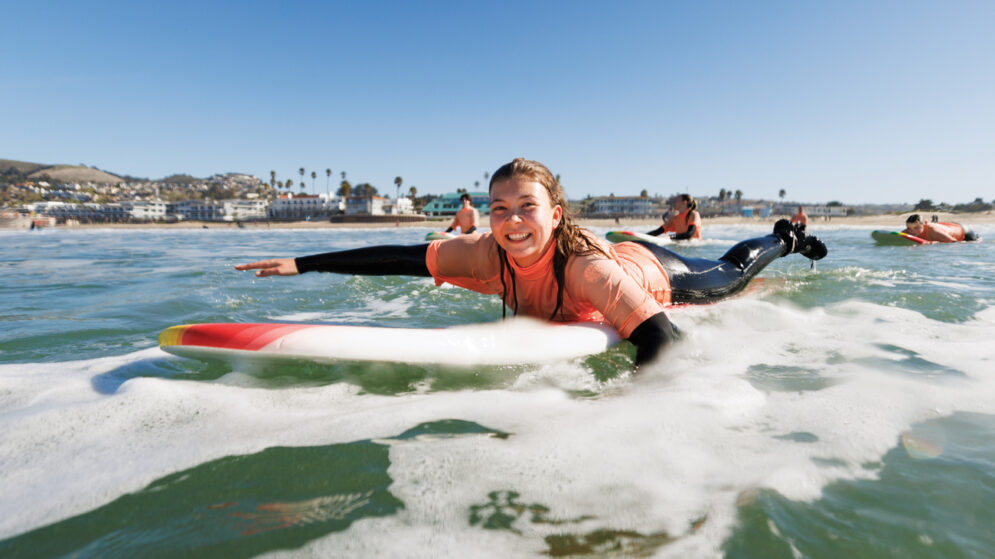Featured
We Belong Together
In an age of loneliness among young people, meet four Mustangs who have found different ways to forge lasting friendships that fuel their joy.
By Robyn Kontra Tanner // Photos: Joe Johnston
Share this article:
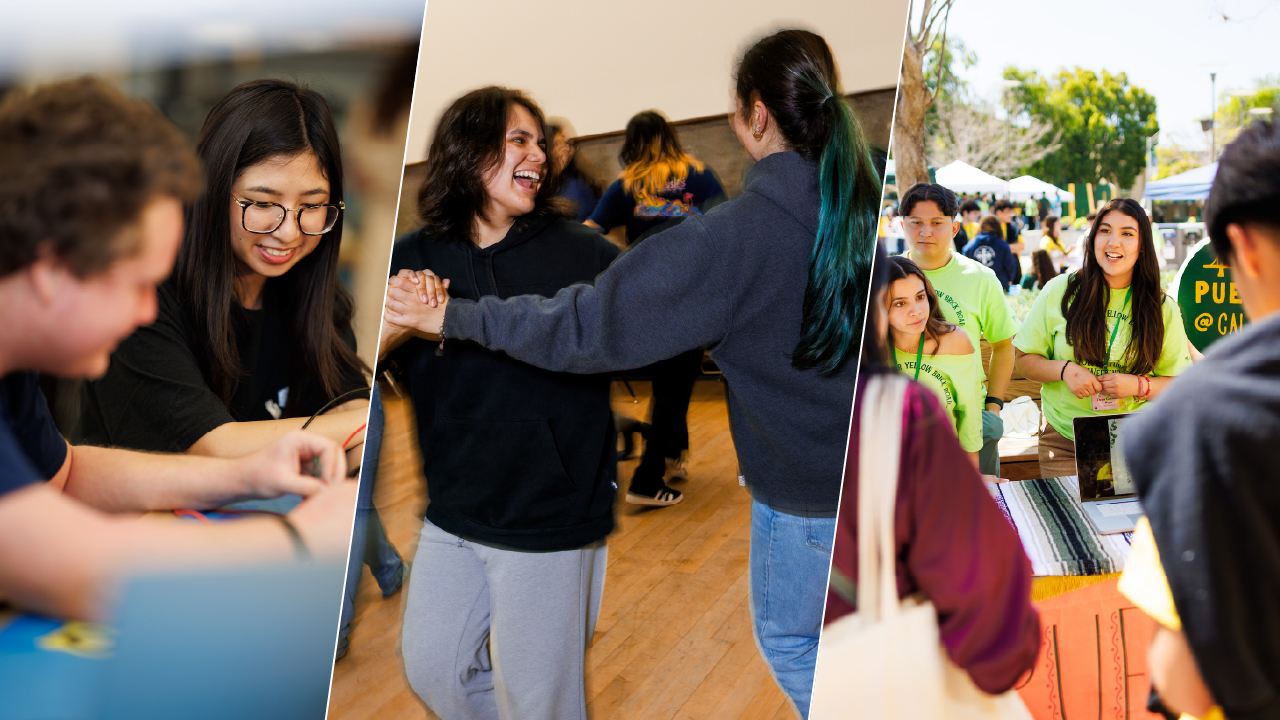
Students bonding in the CubeSat lab, in a dance rehearsal and at a club booth at PolyCultural Weekend.
Among all the things to worry about when starting at a university, most students ponder personal questions: Will I fit in? Will I make friends in this brand-new place, away from my family, while juggling college academics and finances?
The stakes have gotten higher in recent years. In 2023, the U.S. Surgeon General sounded the alarm on the nation’s “epidemic of loneliness.” According to the data, young adults were almost twice as likely to report feeling lonely than people over 65 — and the rate of loneliness among young adults had increased every year between 1976 and 2019.
Clinical psychologist and professor Susana A. López says that people are struggling to connect with one another in the wake of the COVID-19 pandemic. Five years ago, young students transitioning to high school had to rely on technology to interact with their peers — missing out on the benefits of face-to-face interaction that traditionally strengthen social communication skills. As that generation enters college, López says that cultivating lasting friendships is a core part of success at a university. Cal Poly’s ongoing effort to connect students with clubs, activities and one another has a massive psychological benefit, she added.
“We need connection to survive,” she said. “When we don’t get that, it’s when you see not only feelings of loneliness, but potentially mental health challenges.”
In her psychology practice, López finds that everyone needs a different degree of human connection, depending on personality or culture. Matching the level of connection with loved ones and peers is the key to managing daily stress and once-in-a-lifetime curveballs.
“Research shows that social support is one of the key factors in being able to address stress, trauma or challenges in our life. It’s not necessarily money, resources or cognitive ability.
It’s how connected and supported we feel,” López said. “There’s this cyclical component where it feels good for most people to be supportive to others, and likewise, you’re more likely to ask for support because you know what it feels like.”
Cal Poly Magazine met four students who took different routes to find their community and caught glimpses of how they connect with their peers.
Founding the Puente Club
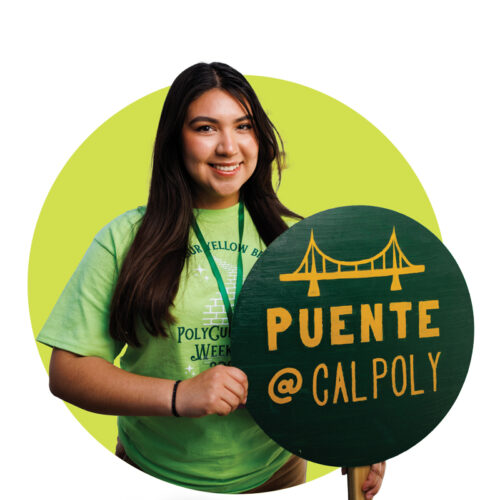
Aerospace engineering student Denis Gonzalez-Reyes.
One of the most important steps in Denis Gonzalez-Reyes’ Cal Poly journey began with the click of a button. She filled out an optional portion of the CSU application that qualified her for the Educational Opportunity Program (EOP), which supports students who face historical, economic and educational disadvantages. The form linked her to the program’s Summer Institute (SI).
Gonzalez-Reyes and 150 fellow first-year students moved onto campus a month before fall quarter began, settled into university housing, tackled six units of coursework and forged friendships with EOP counselors. After just a few weeks in SI, she rooted herself in a community of classmates and neighbors that sustained her as the fast-paced fall quarter began.
“I felt like I belonged right off the bat,” said Gonzalez-Reyes, a first-generation college student. “I didn’t realize it at the time, but that was really instrumental for me to feel confident and mediate that imposter syndrome in the beginning.”
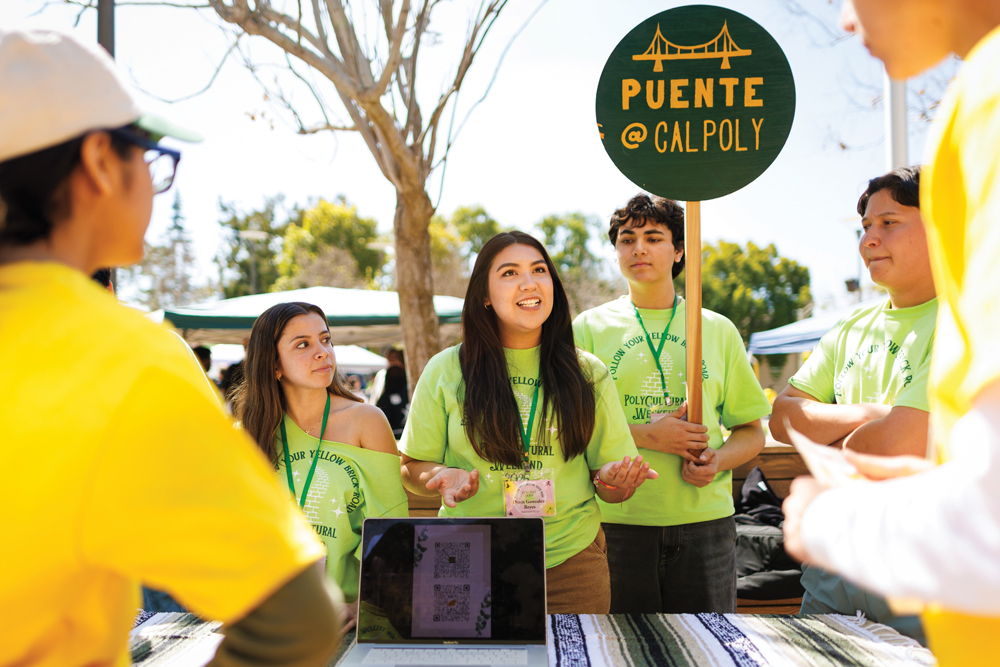
Gonzalez-Reyes (center) talks to prospective students at Puente’s booth during PolyCultural Weekend.
Gonzalez-Reyes decided she wanted to help even more first-generation students make that smooth transition to higher education. She started a Cal Poly chapter of the college-preparatory program Puente — which means “bridge” in Spanish. The organization aims to improve the college-going rate of California’s students through academic instruction, counseling, mentoring and tours of university campuses throughout the state that help prospective students realize their path toward college. Gonzalez-Reyes was a member, or Puentista, at her high school in the Bay Area town of Pittsburg.
“It’s a supportive system we wanted to continue because it was the bridge from high school to a four-year university, but we also want to continue that bridge once you’re in the four-year university to get your degree,” she said. “Those students, like me, need the same support because many of us are first-gen and minorities.”
The club was one of Puente’s first university chapters, so Gonzalez-Reyes looked for an advisor who could match her level of enthusiasm for doing something new. She turned to Roberto Ruiz, an EOP counselor she connected with during SI. His eager attitude and collaboration fueled the program’s ability to win grant funding and attract members. The Puente familia hosts gatherings that feature inspirational guest speakers, frank discussions about overcoming unique challenges, and food — like pan dulce and pozole — that remind students of home.
One of the club’s core activities is also hosting campus tours for other Puente chapters from junior high schools, high schools and community colleges. Cal Poly Puentistas frame their college experience specifically for visiting Puentistas, highlight resources that have helped them personally and answer candid questions about real life as a Mustang. In the club’s first year, it supported roughly 500 students through 10 university tours, and Gonzalez-Reyes says the group is on track to outpace those numbers this year.
“It felt like I was paying it forward,” she said. “The Summer Institute was where I found my community, and when I saw people gravitating towards Puente, I could see others finding their community too.”
Dancing with Imagen y Espíritu de Ballet Folklórico

Environmental management and protection student Luke Mendoza.
Luke Mendoza’s days are packed. The environmental management and protection senior works as a resident advisor in University Housing, gives campus tours to prospective students as a Poly Rep and puts in hours at City Farm SLO for the #CaliforniansForAll College Corps. He’s even a member of his department’s LEAD Scholars Program, where he analyzes effective waste management on campus. To manage stress, he dances twice a week as a member of Imagen y Espíritu de Ballet Folklórico, a troupe known for traditional Mexican folk dancing.
Mendoza never danced before arriving at Cal Poly. But when a student he connected with at the Week of Welcome Club Showcase suggested he join their next rehearsal, Mendoza gave it a shot.
“It’s a testament to how saying yes can be so rewarding,” he said. “When I entered college, I really had no idea what I wanted to make of it, but I said yes to a lot of things. And I think saying yes and being opportunistic has been really amazing.”
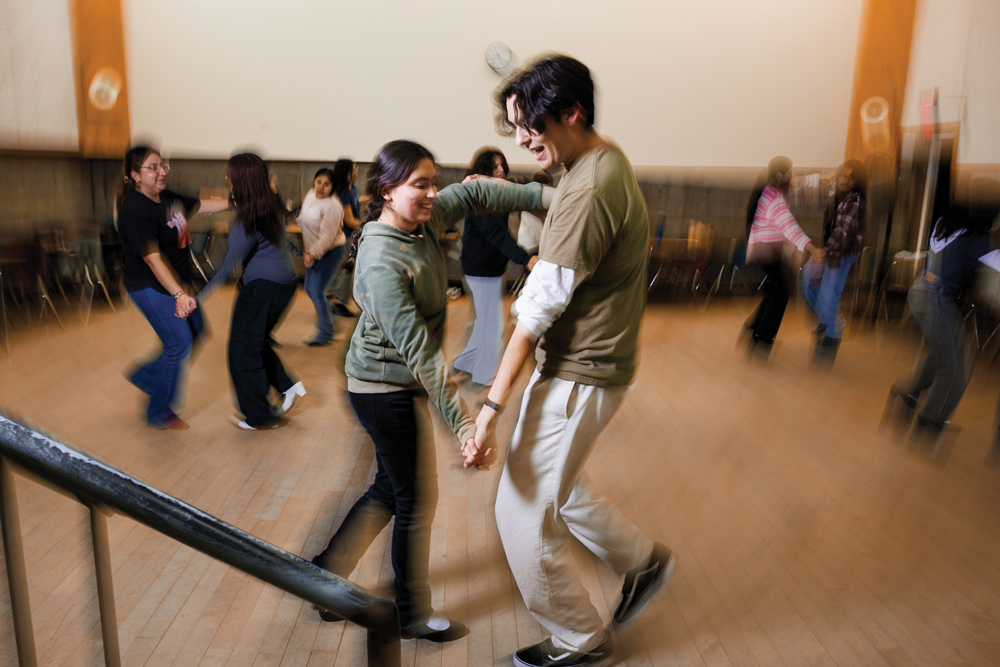
Mendoza (right) dances at a rehearsal for Imagen Y Espíritu Ballet Folklórico.
Mendoza picked up the steps at his first practice and never looked back. He became a general member during his first year, adding practices and regular performances to his weekly schedule. It boosted his mental and physical health, and on diff icult days, he always had Ballet Folklórico to look forward to.
“It was a really good form of consistency for me: I was finding that sense of community, especially with Hispanic students,” he recalled. “I needed to continue doing this because the more that I put into it, the more that I enjoyed it.”
Mendoza is the group’s co-president this year, a leadership role he finds ironic given his quick turnaround to Ballet Folklórico. He takes pride in running a productive and inclusive rehearsal format where members of all skill levels can feel comfortable to dance, make mistakes, talk to their friends and connect.
Each 8 p.m. practice begins with a warmup, leg stretches and run-throughs of the traditional steps paired with folk songs from the Jalisco and Veracruz regions of Mexico. Recently, they’ve included performance pieces from Chihuahua and Monterrey, regions that focus on turns, spins and fast-paced partner work.
“I’ve gathered more knowledge and more confidence in my identity,” said Mendoza of his time in the club. “I’m a Hispanic student, but I’m also a very white-passing student. Being able to individually navigate my identity through performance has helped me feel more confident in myself.
“It makes me feel part of something greater.”
Dining with International Student Friendship
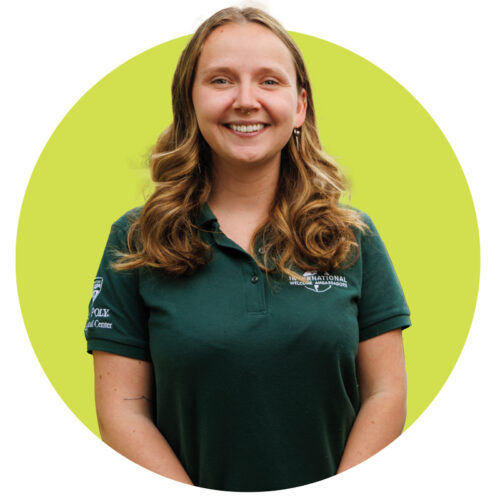
Business administration student Shannon Fracchia.
Shannon Fracchia has one piece of advice for students searching for their niche: don’t be afraid to step away from something that doesn’t truly fit you to make space for what does.
Fracchia, a transfer student who is originally from France, arrived at Cal Poly ready to make the most of her two years on campus. Almost immediately, she stumbled into a treasurer position on the board of an academic club related to her concentration within the business administration major — but there was a catch.
“The setting of the club was not something that I was enjoying,” Fracchia said. “I always wanted to push, to do more, and I felt like that wasn’t happening the way I wanted. That was very frustrating for me.”
When she took time to better understand how she felt, she realized she really wanted a role that involved more face-to-face interaction and events with other students.
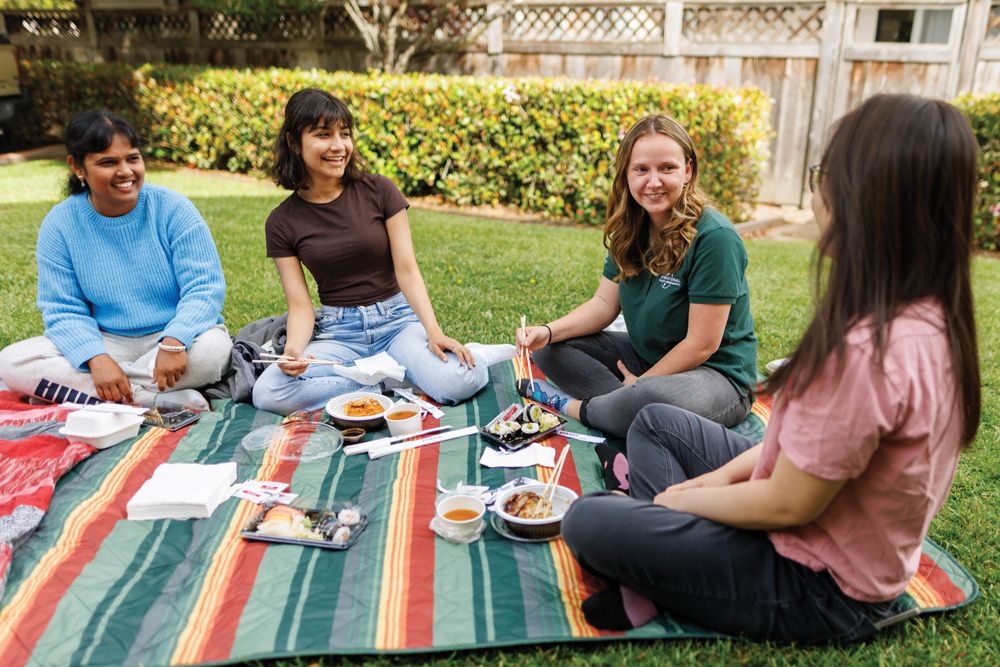
Fracchia (second from right) enjoys a meal with International Student Friendship members Suborna Rani, Mihika Nigam and Quynh Ha.
“I realized, ‘Oh, this is my body telling me what I value,’” she said. “So maybe this is not for me, but it can be for someone else.”
After a conversation with the club’s board, she stepped down from her role with more certainty about what she wanted to pursue. Fracchia joined the team at New Student and Transition Programs, where she’s served as a SLO Days leader and coordinator for key Open House events. She’s also an ambassador with the International Center, where she offers support to her fellow international students and exchange students new to campus.
Fracchia recharges by attending dinners hosted by the International Student Friendship club every two weeks.
“It’s not only connecting around food, but it’s also learning the culture of others, she said. It’s about sharing and meeting new people.”
At each gathering, the several dozen club members explore a different theme, often marking an upcoming cultural holiday with a discussion, a craft and cuisine from a featured region. When Fracchia had the chance to contribute a dish to the club’s colorful table, she brought a taste of home: French crêpes with homemade whipped cream.
“It just brings me back to my culture,” she said. “Even though it’s not always French food, I like the idea of having an actual dinner — really valuing the meal, the time and the conversation.”
Building Satellites with CubeSat
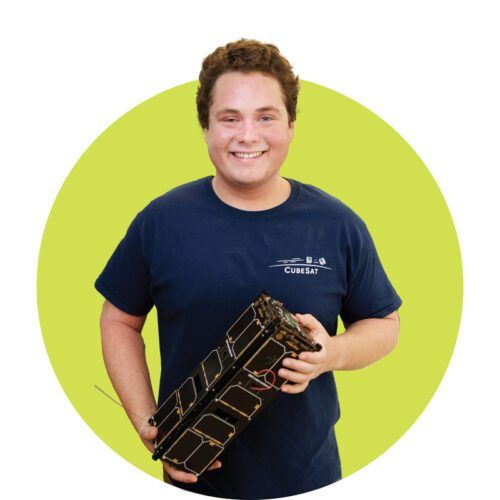
Electrical engineering student Ethan Spalard.
Electrical engineer Ethan Spalard can pinpoint the day that changed his life. The transfer junior was outside a classroom when he saw a flyer about the CubeSat lab recruiting students for its avionics team. By chance, members of that team saw him looking at the flyer, and Spalard struck up a conversation. On the other side of the application and interview process was the band of friends he’d been waiting for.
“That lab is a community. I truly mean it — I love the people I meet there,” he said. “They’re all so smart and totally open to collaborate, which is such a rare combination.”
About 60 students work in the lab throughout the week to build, launch and track compact satellites, a concept that was created in 1999 by former Cal Poly professor Jordi Puig-Suari and now-retired Stanford University professor Bob Twiggs.
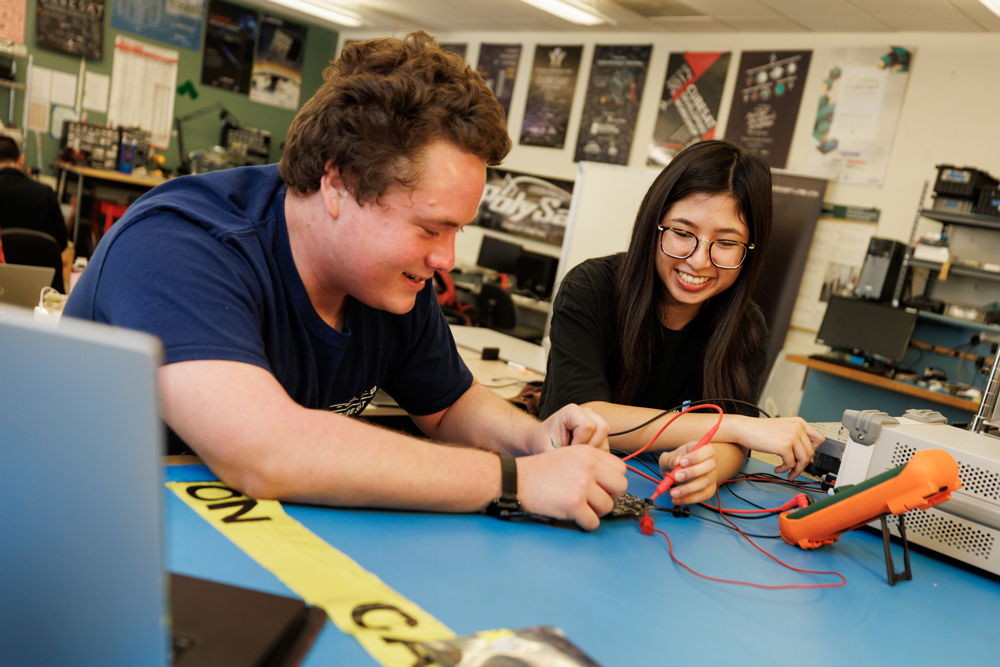
Spalard and Canal work on a circuit board for a CubeSat that will be launched in 2026.
Spalard soon found out that mentorship is central to the lab’s 20-year track record of success. Most CubeSat team members get involved as first- or second-year students, so transfer students can have a hard time getting a foot in the door. Former avionics lead Braydon Burkhardt (Electrical Engineering ’24) took Spalard under his wing, offering him the chance to work on a payload interface board (PIB).
“I’m really excited to try to pay that forward to my mentee, Francine Canal,” said Spalard. “We can relate on the classes she’s going through, and I give her advice. We laugh and share about the common transfer experiences.”
Before long, Spalard was promoted to the responsible engineer role for the PIB for the SAL-E CubeSat, which is on track to launch into space in 2026. He says he’ll never forget a moment from last fall that summed up his whirlwind experience. Aft er months learning new soft ware, laying out the circuit board and overcoming mistakes, he held the most complex board he’s made to date, surrounded by mentors Burkhardt, avionics lead Christopher Tinker and computer science professor and CubeSat lab director John Bellardo.
“I genuinely mean it when I say lab changed everything for me,” says Spalard, who is now working toward a master’s degree in electrical engineering at Cal Poly. “I remember people would ask me, ‘What do you want to do aft er you graduate?’ I just didn’t know, and it was scary. And the CubeSat lab blew that question away for me. I have it solved now. That alone feels so good — to have a clear goal and direction.”
Your Next Read
Follow the student cast and crew of Cal Poly’s production of “Clue: The Musical” as they put Learn by Doing on center stage.
Cal Poly’s student-run adventure series gives Mustangs an accessible entry point into the great outdoors.



